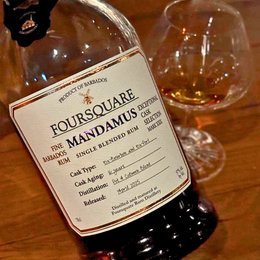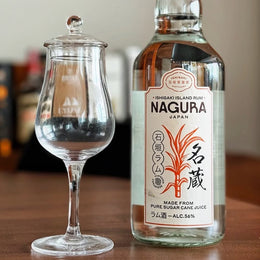
Background: these need no introduction. A friend happened to be at The Golden Promise in Paris, and asked if I were interested in any of their rums. Of course I was. The bar charged 600 euros for 2cl of Skeldon 1978. In the same week, another friend opened his bottle of Port Mourant 1974 and shared samples of the liquid therein. A comparison between the two rums became a no-brainer.
Name: Velier Skeldon 1978 (27 years)
Nose: a good balance of sweetness, acidity and umami; cola and root beer, complete with (the illusion of) fizziness; a boatload of gummy bears and liquorice sticks, immediately reminiscent of this Rum Club 1983 Gardel, albeit less expressive; herbal candy, herbal tea and yes, herbal soup; this is where the savouriness becomes obvious; in addition to the herbs, there is a ton of meat and seafood – think pork ribs and clams and whelk; stir-fried chicken in dark soy sauce and Marmite; the roastiness of an old highland malt; sweet-savoury coconut based pastries the likes of kueh dadar; it gets more milky and buttery over time; Tibetan butter tea; cookie dough; toffee; there are flashes of a legendary sherried Mortlach, but far dirtier; a nice, piercing acidity eases the richness; pineapple and sour mango; star fruit garnished with salt; the base notes are metallic and briny, redolent of rust, pickled vegetables and olives.
Palate: rich and unctuous; impeccable alcohol integration; some butter, but mainly a big dose of fatty yoghurt; a red-fruit-laden smoothie; strawberries – even raspberries – and cream; as on the nose, it gets progressively more umami; mango sticky rice; som tam; fresh herbs in curries; almost a full-course Thai meal to be had here; the mid-palate is drying, likely due to the oak influence; salmiak; freshly cut branches and grass; a variety of incense, most notably creamy sandalwood; potpourri; almond and walnut paste; a whiff of vegetal rot; gan cao and other traditional Chinese herbs; assorted twigs and vines; the back-palate brings back the fruits; pickled sour plum; dried apricot and mango; crystallised pineapple.

Finish: long; starts out dark and brooding – a stark shift in direction from the candied fruits on the back-palate, but also a further evocation of old Sauternes wines; toffee; creme brulee; Christmas cake; milk chocolate; before long it is the tannins’ turn to shine again; this time the astringent oak leads an ensemble of brine and minerality rarely found in later Savalle-still marks; freshly roasted coffee beans; coffee dregs; concentrated black tea; green vines and stems and tree barks typical of an old pomace brandy; copper coins; pickled vegetables; more olives; wet rocks; tobacco, mint, and a vague plasticky note combine to leave the impression of heat rub; dried fruits anchor the aftertaste, providing clear and long-lasting notes of figs and apricots and sultanas.
Conclusion: just shy of being overoaked, there is a stunning amount of character here. You see, I have learned to expect no more than a straightforward feel-good experience from Velier demeraras, so the wonderful complexity and development on display took me aback. Of course, such a surprise can only be pleasant, considering the amount I paid for a sample. Maybe I should feel bad for fuelling the hype, but I have to say, this is probably the best Guyanese rum not distilled in a wooden pot still.
Score (assuming a normal distribution with mean 50): 91/100
Name: Velier Port Mourant 1974 (34 years)
Nose: at once, I can tell this does not play in the same league as the Skeldon; the top notes are a combination of earth and sweetness; chocolate; old wooden furniture, varnished and musty; pencil shavings; petrichor; magic markers; the heart and base notes are dark, herbal and lightly fruity; herbal candy; cough syrup; lots of roots, as in root beer, and as in fresh roots out of the soil; liquorice galore, though somehow less densely packed than in the Skeldon; brown sugar; dark fruits the likes of dried fig and raisins and Luxardo cherries; a disappointing lack of brine, savouriness, even acidity.
Palate: good body; there is a good amount of richness, but also a good deal of tannins; this is squarely over the hill in terms of oak management – surprising considering it is continentally aged; cherries served many ways – fresh, candied, in cough syrup; dried prunes and fig; liquorice; grass jelly; that distinct Port Mourant greenness, more subdued here than in other bottlings; the greenness manifests as gan cao, damp wood, plant sap, crushed almonds and fresh cuttings; some fresh herbs like tarragon and fennel also show up, making the mid-palate green Chartreuse-adjacent; confectionery is the back-palate, with notes of dark chocolate, gingerbread, shortcrust pastry and coconut shavings.
Finish: long; this is continental-aged Port Mourant, alright; black tea, herbal candy and yet more liquorice gradually make way for hints of sweat, vinegar and olives; Penang nutmeg juice; cinnamon candied apple; the light brine and acidity persist in the aftertaste, joined by mandarins and indistinct yellow tropical fruits.
Conclusion: the nose on this is painfully one-dimensional next to the Skeldon. Thankfully, the palate and finish pick up enough of the slack. I could hardly believe this is continentally aged – must have been a very active barrel – given how dark and rich it is. Yet in equal measure, it is grippy and tannic and lacking the balance I expected from Luca. The Port Mourant distillate saves this from being too simple, but let’s face it, there are plenty of better demerara rums available at a fraction of the cost.
Score (assuming a normal distribution with mean 50): 86/100
Image Courtesy of u/zoorado.
![]()
u/zoorado







